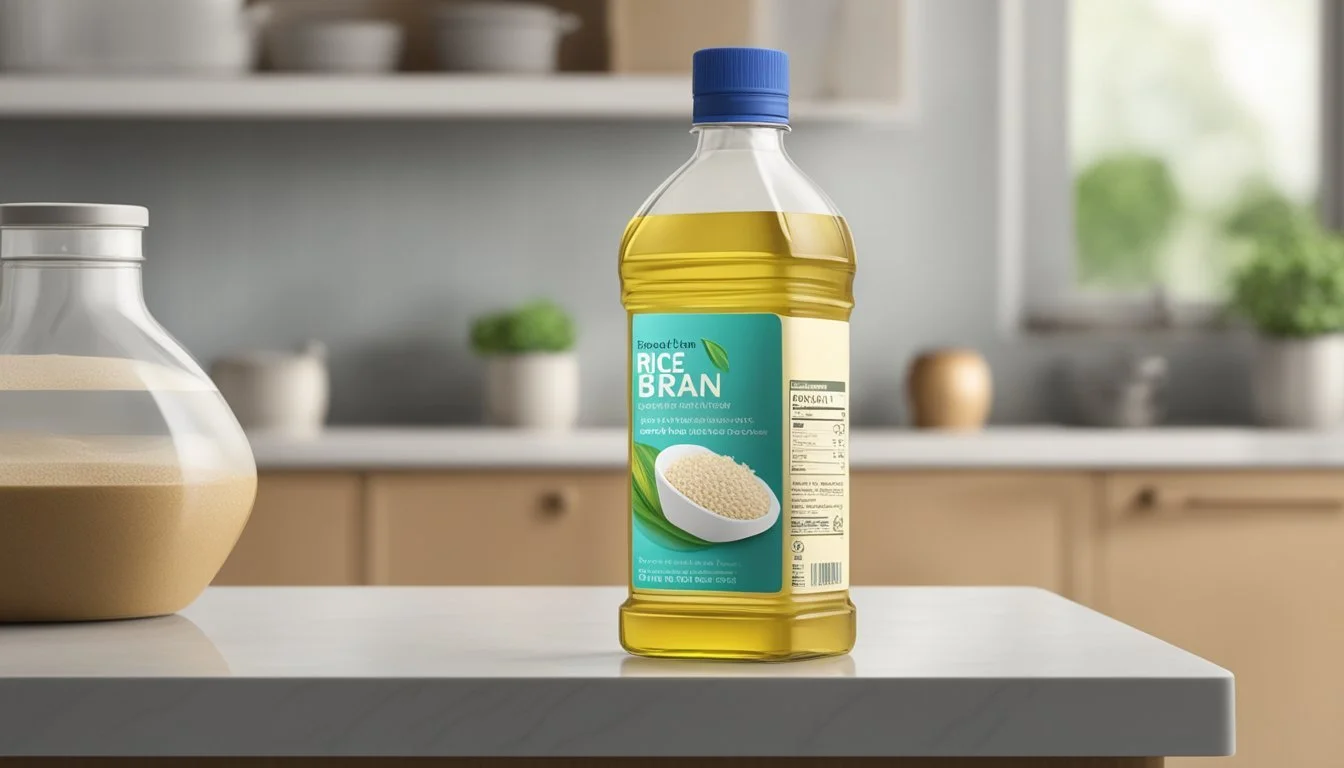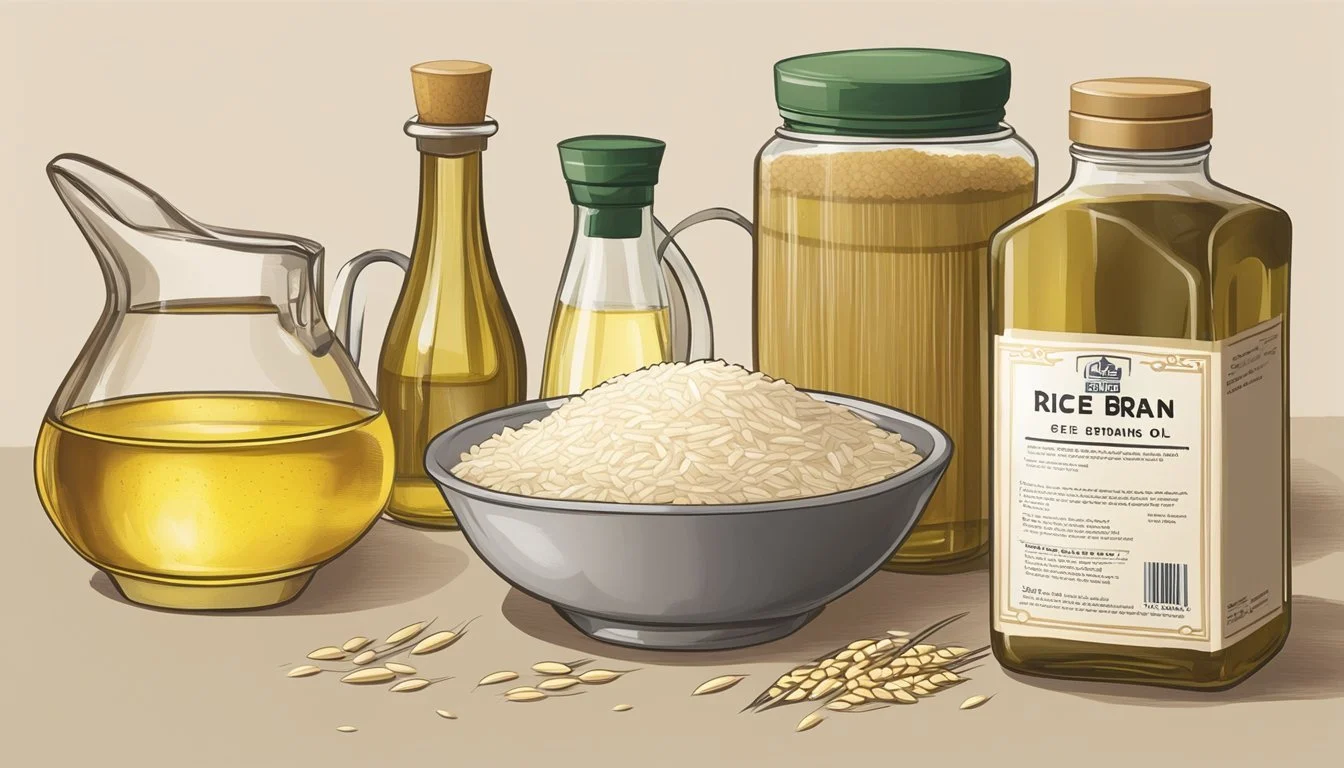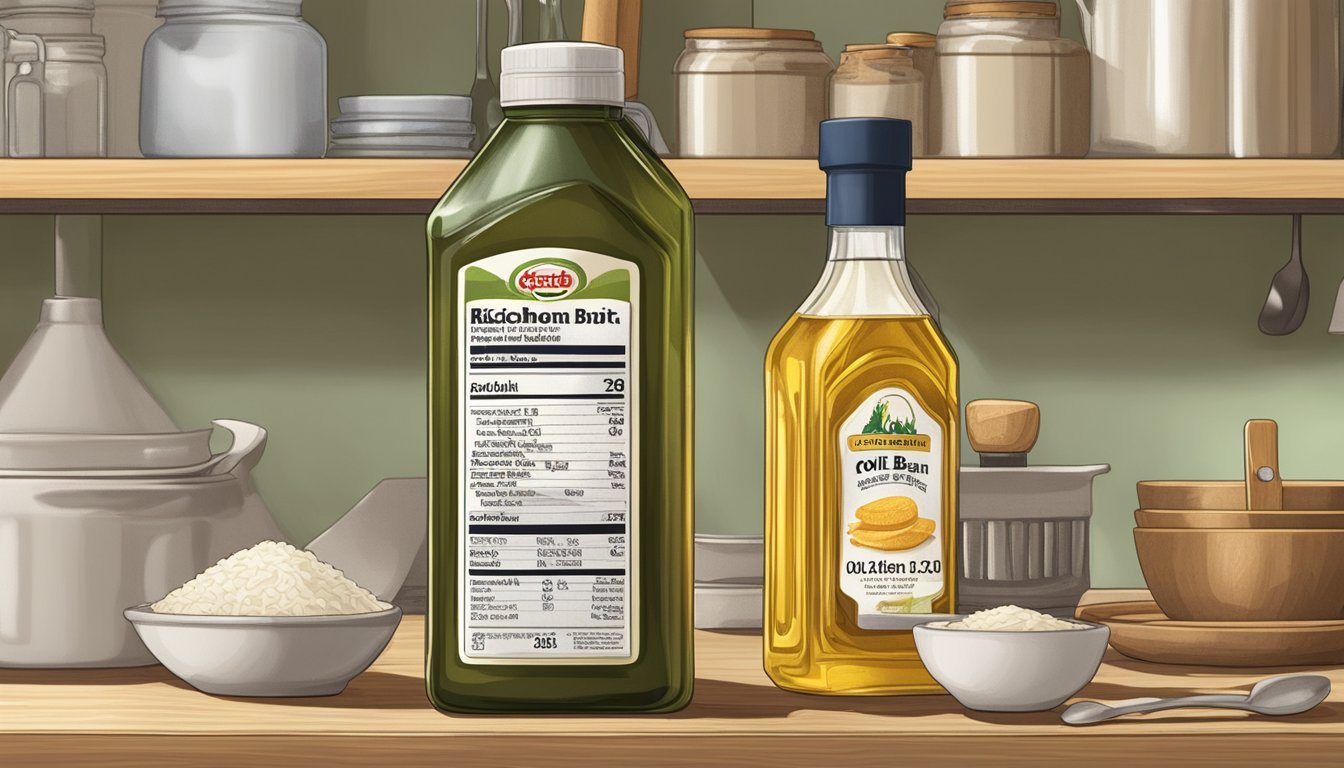How Long Does Rice Bran Oil Last?
Shelf Life and Storage Tips
Rice bran oil, extracted from the hard outer brown layer of rice called chaff, has gained popularity as a versatile oil for cooking and dietary purposes. It is revered for its relatively high smoke point and a balanced fatty acid composition, which makes it a suitable choice for various culinary techniques, including frying and sautéing.
Shelf life is a crucial aspect for consumers to consider for maintaining the quality and nutritional value of rice bran oil. Typically, unopened rice bran oil has a shelf life of 1 to 2 years if stored properly in a cool, dark place, away from heat and light, which can accelerate spoilage. Once opened, rice bran oil is best used within 6 months to ensure its freshness and prevent rancidity. Proper storage and handling can significantly influence the oil's longevity, which lines up closely with those of other carrier oils such as grapeseed and almond oil.
Composition and Nutritional Profile
Rice bran oil's unique composition, distinguishing it from other cooking oils, is characterized by a balance of fats and a rich supply of nutrients, including a significant amount of vitamin E and antioxidants.
Fatty Acid Breakdown
The fatty acid profile of rice bran oil primarily consists of approximately 47% monounsaturated fats, 33% polyunsaturated fats, and 20% saturated fats. This combination provides a stable blend that contributes to rice bran oil's notable shelf life. Specifically, it contains both omega-6 and omega-3 fatty acids, which are essential for health but need to be balanced in the diet.
Monounsaturated Fat: About 47%
Polyunsaturated Fat: About 33%
Saturated Fat: About 20%
Vitamins and Antioxidants
Rice bran oil is especially high in Vitamin E, with about 4.39 milligrams per serving, which plays a role in its longevity and resistance to rancidity. It also contains unique antioxidants such as oryzanol and gamma oryzanol, along with phytosterols, tocopherols, and tocotrienols, which are all compounds that can contribute to the preservation of the quality and nutrition of the oil over time.
Vitamin E: Approximately 4.39 milligrams per serving
Antioxidants:
Oryzanol
Gamma Oryzanol
Phytosterols
Tocopherols
Tocotrienols
These components not only contribute to the oil's stability and extended shelf life but also offer various health benefits, making rice bran oil a desirable option for those looking for a nutritious edible oil.
Health Benefits
Rice bran oil offers multiple health benefits, particularly in enhancing cardiovascular health, managing cholesterol levels, and providing anti-inflammatory properties.
Cardiovascular Health
Rice bran oil contains healthy fats that can support the maintenance of a healthy cardiovascular system. Its balanced fatty acid composition contributes to overall heart health by potentially reducing the risk of cardiovascular diseases.
Cholesterol Management
One of the key advantages of rice bran oil is its ability to help manage cholesterol levels. Clinical studies suggest that it can lower total cholesterol levels, including both low-density lipoprotein (LDL) and high-density lipoprotein (HDL), which might mitigate the risk of heart disease.
Anti-inflammatory Properties
Rice bran oil exhibits anti-inflammatory properties that may reduce chronic inflammation in the body. This can be attributed to the presence of compounds that combat free radicals, thus potentially decreasing inflammation-related health issues.
Storage Recommendations
Proper storage of rice bran oil is critical for maintaining its quality and longevity. This section provides clear instructions on creating the ideal conditions to store rice bran oil and understanding its shelf life and expiration date.
Ideal Conditions
Rice bran oil should be stored in a cool, dark place, such as a pantry or cupboard, away from direct sunlight and heat to preserve its freshness. Keeping the oil in an airtight container is essential to minimize exposure to air and humidity, which can speed up the degradation process. While refrigeration is not necessary, it can extend the oil's shelf life.
Location: Cool pantry or cupboard
Temperature: Ambient, away from heat sources
Lighting: Dark, no direct sunlight
Container: Airtight to reduce air and humidity exposure
Shelf Life and Expiration Date
Unopened rice bran oil generally has a shelf life of up to 1-2 years when stored properly. Once opened, its optimal use is within 6 months to maintain quality. If stored in the refrigerator, rice bran oil can last between 9-12 months. The expiration date on the packaging can serve as a guideline, but it's the storage conditions that play a pivotal role in the actual longevity of the oil.
Unopened Shelf Life: 1-2 years in cool, dark conditions
Opened Shelf Life: Up to 6 months under optimal conditions
Refrigeration: Can extend shelf life to 9-12 months
Note: Always check for signs of rancidity or off-flavors before use
Factors Affecting Longevity
The shelf life of rice bran oil is influenced by several environmental and material factors that determine its freshness and usability. These elements can accelerate the processes that cause the oil to spoil, such as oxidation.
Exposure to Elements
Light: Rice bran oil is sensitive to light, specifically direct sunlight. Prolonged exposure can induce oxidation, reducing the oil's shelf life.
Heat: Elevated temperatures increase the rate of oxidation and can cause rice bran oil to go rancid more quickly.
Air: When rice bran oil comes into regular contact with air, it undergoes oxidation, which can diminish its freshness.
Moisture: The presence of moisture can lead to spoilage, therefore rice bran oil should be kept in a dry place to maintain its quality.
Packaging and Quality
Packaging: The type and quality of packaging significantly affect rice bran oil's longevity. Whether it's in airtight containers or those that allow for more air exposure will influence its shelf life.
Quality: The inherent quality of the oil, including how it was processed and refined, sets the baseline for its durability. Higher quality oils tend to have a longer shelf life when stored properly.
Identifying Spoilage
When rice bran oil begins to spoil, it manifests noticeable changes in its quality, including alterations in odor, color, and texture. The consumer’s safety is paramount, and understanding how to spot these changes is key to avoiding the consumption of rancid oil.
Changes in Quality
Odor: A neutral or slightly nutty aroma indicates fresh rice bran oil. Spoilage is often accompanied by a rancid or sour smell, which denotes the presence of oxidation.
Color: Good rice bran oil usually has a pale yellow or golden hue. Any darkening or off-color appearance can signal degradation.
Texture: While rice bran oil is typically smooth, a thickened or sticky consistency could suggest spoilage.
It's important to note that a simple taste test, detecting a bitter or odd flavor, can also serve as an indicator of rancidity.
Safety Considerations
Consumers should discard any rice bran oil that exhibits signs of spoilage to prevent potential health risks associated with consuming rancid oils. Ensuring the oil is stored correctly—away from direct sunlight and in a tightly sealed container—can help mitigate these risks. The consumption of spoiled oil is not recommended as it could lead to food-borne illnesses.
Culinary Uses
Rice bran oil's versatility in the kitchen is attributed to its high smoke point and mild, slightly nutty flavor, making it a reliable choice for various cooking methods.
Cooking and Frying
Rice bran oil is ideal for frying and sautéing due to its high smoke point of approximately 490 degrees Fahrenheit. This characteristic ensures the oil remains stable and doesn't break down or smoke excessively when exposed to high heat. It's a suitable option for stir-frying where consistent heating is required and can also be used for deep frying due to its ability to withstand prolonged heat without affecting the food's flavor.
Baking and Salad Dressings
In baking, rice bran oil serves as a healthier fat option compared to butter and other saturated fats. It imparts a smooth texture to baked goods without overpowering their taste. The oil's neutral profile also makes it a suitable component for salad dressings and dipping oils, blending well with other ingredients to create balanced and flavorful concoctions.
Comparing Cooking Oils
In this section, the longevity, smoke points, and flavor profiles of various cooking oils are contrasted, along with their nutritional values and health implications, offering a comprehensive understanding of how they stack up against each other.
Smoke Points and Flavor Profiles
Rice Bran Oil: Boasts a high smoke point of around 490°F, making it suitable for high-temperature cooking with a mild, slightly nutty flavor.
Extra-Virgin Olive Oil: Lower smoke point around 320-375°F, best for dressings or low-heat cooking, with a distinctive taste.
Regular Olive Oil: Higher smoke point near 465°F, a more neutral taste compared to extra-virgin.
Vegetable Oil: A blend of oils like soybean, corn, or canola with a smoke point around 400-450°F and a relatively mild flavor.
Canola Oil: Similar to rice bran oil, offers a neutral flavor and a high smoke point near 400°F, making it a versatile choice for various cooking methods.
Avocado Oil: With a high smoke point at around 520°F, it's excellent for searing and frying, yet has a subtle, buttery flavor.
Grape Seed Oil: Contains a smoke point of approximately 420°F and possesses a clean flavor profile that doesn't overpower dishes.
Peanut Oil: Noted for its high smoke point of 450°F and strong, nutty flavor, ideal for deep frying and Asian cuisine.
Walnut Oil (how long does walnut oil last?): Should be used for its flavor rather than cooking utility due to a lower smoke point; used mostly in salad dressings and to flavor finished dishes.
Health and Nutritional Comparison
Saturated Fats:
Coconut Oil: High in saturated fats, which are more stable at high temperatures.
Oils like olive oil and canola oil contain lower levels of saturated fats.
Monounsaturated Fats:
Olive oil (especially extra-virgin) and avocado oil are rich in monounsaturated fats, beneficial for heart health.
Polyunsaturated Fats:
Oils such as soybean, walnut, and grape seed are high in polyunsaturated fats, including essential fatty acids.
Shelf Life:
Rice bran oil generally lasts between 9 to 12 months, similar to grape seed and walnut oils.
Avocado oil, known for its monounsaturated fats, also shares a comparable shelf life.
Edible Oil Nutritional Value Table:
Oil Type Smoke Point (°F) Saturated Fat (%) Monounsaturated Fat (%) Polyunsaturated Fat (%) Rice Bran Oil 490 Low Moderate High Olive Oil (Extra-Virgin) 320-375 Moderate High Low Canola Oil 400 Low High Moderate Avocado Oil 520 Low Very High Moderate Walnut Oil Low (for finishing, not cooking) Moderate Moderate High
The nutritional profiles and smoke points of these oils make them suitable for different cooking styles and dietary needs, with each oil offering distinct advantages for culinary and health purposes.
Contextual Insights
In considering the shelf life of rice bran oil, it's important to understand the regions of production and the evolving market and research trends which influence its usage and storage guidelines.
Geographical Production
Rice bran oil is primarily extracted from the hard outer brown layer of rice called bran. The leading producers are countries in East Asia, with India and China at the forefront, collectively accounting for a major percentage of the global rice trade. The oil's characteristics and shelf life are closely tied to these regions' agricultural practices and climatic conditions.
Market and Research Trends
The market for rice bran oil has been expanding, driven by research indicating its health benefits, such as being a good source of antioxidants and nutrients. This shift is particularly evident in the wellness community, where there is a steady demand for healthier oil options. Researchers and writers within the health sector are actively engaging in studies that explore the storage, longevity, and nutritional profile of rice bran oil, which in turn influences consumer preferences and storage practices.










